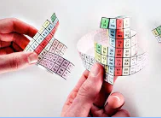Periodically, I look at the periodic table and think - that’s not very well designed.
我定期地看元素周期表,然后想,它设计得不是很好。
Like, look at this big tall column on the left, and then a big gap, and then more tall columns on the right.
看看左边高高的一列,然后是一个大的缺口,然后是右边高高的几列。
It doesn’t feel very natural - so let’s rearrange the table!
看起来不是很自然,所以我们来重新安排这张表!
Obviously we don’t want to ignore physical reality, but the idea of the periodic table, roughly speaking,
显然,我们不想忽略物理现实,但是粗略地说,元素周期表的概念
is that atoms are listed horizontally according to increasing atomic number and grouped vertically according to shared properties,
原子按照原子序数的递增水平排列,按照共有性质垂直排列,
so these breaks here on the left and right, where it goes from element 10 on the right to 11 way on the left - those are artificial.
所以左边和右边的这些断点,从右边的第10号元素到左边的第11号元素这些都是人工的。
We should really be cutting the periodic table out and then taping the edges together, into a nice loop.
我们应该把元素周期表剪下来然后把边缘粘在一起,形成一个漂亮的循环。
Kind of like how there isn’t actually a giant disconnect between Russia and Alaska, even if maps make it seem like that.
就像俄罗斯和阿拉斯加之间实际上并没有巨大的鸿沟,即使地图上看起来是这样。
Anyway, once you join the Russia and Alaska of the periodic table,
不管怎样,一旦你在元素周期表中把俄罗斯和阿拉斯加连起来,
it makes a different location seem like the obvious place to cut if we really want a flat table - right here.
它的位置就会不同,如果我们想要一个平面的表的话,似乎这就是明显要切割的地方。
Then we get the left-step periodic table, where the columns are all nicely stair-stepping down,
然后我们得到了左边台阶式元素周期表,每一列都很好地阶梯式下降,
though really it’s even nicer if helium moves up above beryllium and next to hydrogen where it so obviously belongs.
但如果氦移到铍之上,靠近氢,那就更好了。
This way of organizing the table looks really nice and makes a fair bit of sense from a physics perspective,
这种组织周期表的方式看起来很棒,在物理角度上很合理。
even if it doesn’t have the nice properties of normal periodic tables
即使它不具备常规元素周期表的优良性质,
where electronegativity and first ionization energy increase from left to right and bottom to top.
即电负性和第一电离能从左到右、从下到上递增。
But really, the periodic table should be a loop.
但是真的,元素周期表应该成为一个闭环。
The problem is, we still have a gap between elements 20 and 21, maybe we can loop them too?
问题是,20号元素和21号元素之间还有一个间隙,或许我们也把这里连上?

And what about 4 and 5? If we join them, we have a nice spiral periodic table, with no gaps between any of the numbers!
4号和5号元素呢?如果我们把他们连在一起,我们会有一个很棒的螺旋元素周期表,任何元素之间都没有间隙!
Though it’s even nicer if helium moves over above neon where it so obviously belongs.
如果氦移到氖的上方,那就更好了。它明显属于那里。
This version kind of looks like a tiered cake, and goes really well on top of pointy trees!
这个版本看起来像一个分层蛋糕,非常适合放在尖尖的树顶上!
Except in this table, elements with similar properties aren’t grouped together vertically anymore.
除了在这个表中,具有相似属性的元素不再垂直地组合在一起。
So we could attach the ones that are supposed to be grouped vertically,
所以我们可以连接那些应该垂直排列的,
which forces us to make some folds, and now we get this spiral rosette-y periodic table, sometimes called “Mendeleev’s flower.”
这迫使我们做一些折叠,现在我们得到了这个螺旋形的罗塞特-y周期表,有时被称为“门捷列夫之花”。
This really shows the structure of the table nicely,
这很好地展示了周期表的结构,
though it’s not really a table any more, and it’s way too three dimensional for a lot of uses.
尽管它不再是一个周期表了,而且它对很多用途来说都太三维了。
So let’s unspiral the spiral, and go back to basics - the one dimensional periodic table.
所以我们来解螺旋,回到基本的一维元素周期表。
It’s actually pretty long!
它实际上非常长!
And it’s a lot harder to see the structure, though you can still see that certain properties repeat periodically - hence, periodic table.
这样看到结构会更加困难,尽管你仍然可以看到特定的性质周期性的重复,就是元素周期表。
And if you match up those repeated patterns, and cut in all the right places,
如果你把这些重复的模式匹配起来,并在所有正确的地方切割,
and do some surgery, you arrive back at the familiar - if not super elegant - traditional periodic table.
做一些手术,你回到熟悉的——如果不是非常优雅的话——传统的元素周期表。


